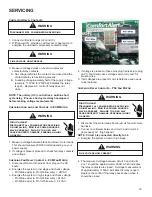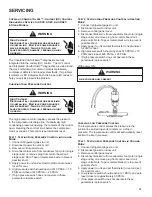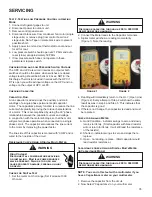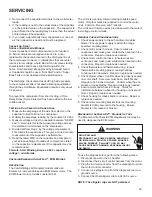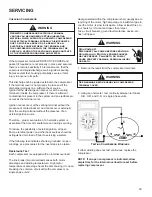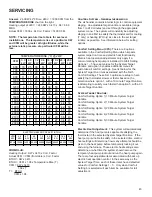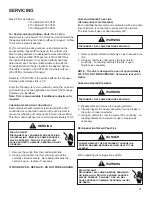
SERVICING
32
Checking Transformer and Control Circuit
WARNING
High Voltage!
Disconnect all power before servicing
or installing. Multiple power sources
may be present. Failure to do so may
cause property damage, personal injury
or death.
A step-down transformer (208/240 volt primary to 24 volt
secondary) is provided with each indoor unit. This allows
ample capacity for use with resistance heaters. The
outdoor sections do not contain a transformer (see note
below).
NOTE: Communicating condensing units may have an
optional 240VAC to 24VAC transformer installed. This
transformer provides 24VAC power to the unitary (UC)
control in some communicating system installation
scenarios.
WARNING
Disconnect ALL power before servicing
1. Remove control panel cover, or etc., to gain access to
transformer.
With power ON:
WARNING
Line voltage now present
2. Using a voltmeter, check voltage across secondary
voltage side of transformer (R to C).
3. No voltage indicates faulty transformer, bad wiring, or
bad splices.
4. Check transformer primary voltage at incoming line
voltage connections and/or splices.
5. If line voltage available at primary voltage side of
transformer and wiring and splices good, transformer is
inoperative. Replace.
Checking Time Delay Relay
Time delays are used in electric heaters to sequence in
multiple electric heaters.
WARNING
Disconnect ALL power before servicing
1. Tag and disconnect all wires from male spade
connections of relay.
2. Using an ohmmeter, measure the resistance across
terminals H1 and H2. Should read approximately 150
ohms.
3. Using an ohmmeter, check for continuity across
terminals 3 and 1, and 4 and 5.
4. Apply 24 volts to terminals H1 and H2. Check
for continuity across other terminals - should test
continuous. If not as above - replace.
NOTE: The time delay for the contacts to make will be
approximately 20 to 50 seconds and to open after the
coil is de-energized is approximately 40 to 90 seconds.
Testing Coil Circuit
Checking Unitary (UC) Control Compressor
Summary of Contents for ASXC16
Page 4: ...PRODUCT IDENTIFICATION 4 ...
Page 5: ...PRODUCT IDENTIFICATION 5 ...
















